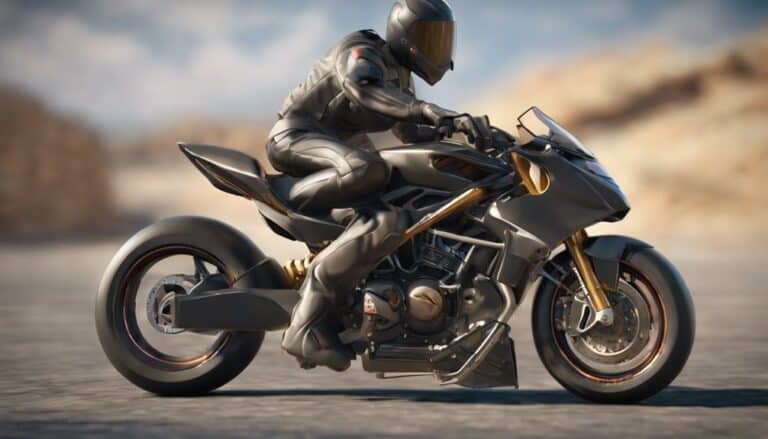When negotiating corners on your bike, you might wonder how important body positioning really is to prevent sliding. Well, by understanding the impact of your body's placement on traction, you can greatly enhance your control and minimize the risk of skidding.
But there's more to it than just leaning into the turn. By mastering the art of weight distribution and alignment, you can unleash the full potential of your bike's grip on the road.
So, how can you guarantee your body positioning is optimized for maximum traction and safety?
Key Takeaways
- Keep weight centered over tires to maximize traction and control.
- Lean the bike under you while aligning body over tires for improved grip.
- Adjust body position to prevent sliding and maintain traction.
- Distribute weight effectively for stability and increased grip on tires.
Importance of Proper Body Positioning
To maximize traction and control while riding, mastering proper body positioning is essential. When you lean into a corner, your body position directly affects the bike's lean angle and weight distribution. By shifting your weight correctly, you guarantee that the front tire's contact patch maintains ideal grip with the road surface. This is vital for achieving maximum traction as you navigate corners at higher speeds.
Proper body positioning not only enhances your control over the bike but also increases stability during cornering maneuvers. Incorrect body positioning, on the other hand, can lead to a loss of traction and potentially result in a slide while riding. By understanding the importance of body position and its impact on lean angle and weight distribution, you can greatly reduce the risk of sliding and improve your overall riding experience.
Body Positioning Techniques for Traction
When aiming to enhance traction while riding, implementing strategic body positioning techniques is important for optimizing control and stability on your motorcycle. To maximize traction effectively, consider the following:
- Center of Mass: Keeping your weight centered over the tire contact patch is essential for increasing cornering traction and stability. By staying balanced, you enhance control and minimize the risk of sliding.
- Lean Angles: Leaning the bike under you while ensuring your body remains over the tires can greatly improve overall grip and control. This technique allows you to maintain traction through corners and navigate more smoothly.
- Friction and Grip: Correct rider positioning in relation to the bike directly impacts the friction and grip levels of the tires. Lowering your center of mass with proper body positioning positively influences traction in corners, leading to better cornering skills and overall stability on the road.
Adjusting Body Position to Prevent Sliding
Adjust your body position to prevent sliding by keeping your weight low and centered during cornering to increase traction and stability.
When you lean the bike into a turn, make sure that your body stays aligned over the tires to prevent excessive sliding.
By maintaining a centered position, you enhance tire friction and grip on the road surface, reducing the risk of losing traction.
Proper weight distribution over the tires is important for stability, especially when maneuvering corners at higher speeds.
Adjusting your body position not only improves traction but also minimizes the chance of sliding, giving you better control over your motorcycle.
Remember, a balanced and low body position can greatly impact your riding experience by maximizing grip and minimizing the risk of sliding out, ultimately keeping you safe on the road.
Maximizing Traction Through Body Alignment
Maximizing traction through precise body alignment is essential for enhancing control and stability while riding. To optimize your body positioning for maximum traction, consider the following:
- Best Weight Distribution: Proper body alignment allows you to distribute your weight effectively over the tires, increasing traction during cornering and minimizing the risk of sliding.
- Maintaining Center of Gravity: Leaning your body along with the bike helps in keeping a stable center of gravity, reducing the chances of sliding and enhancing control.
- Maximizing Contact Patch: Aligning your body low and centered over the bike increases the contact patch area with the road surface. This maximizes the grip on the tires, providing better cornering stability and control.
Common Mistakes in Body Positioning
To enhance your riding performance, it's important to be mindful of common mistakes in body positioning that can affect traction and control on the road. Leaning excessively off the bike can disrupt your center of gravity, leading to decreased traction. Similarly, placing too much weight on the inside arm can impede your steering control and compromise overall traction. Incorrect foot positioning on the footpegs may limit your ability to shift weight effectively, impacting your traction optimization.
Furthermore, failing to maintain a dynamic body position throughout the corner can result in inconsistent levels of traction. It's vital to remember that core stability and proper posture play a significant role in adjusting weight distribution for maximum traction. By understanding and avoiding these common errors in body positioning, you can greatly enhance your ability to maximize traction and improve your overall riding experience. Remember, small adjustments in body position can make a substantial difference in your control and safety on the road.
Conclusion
To sum up, by maintaining a low and centered body position, leaning the bike while staying over the tires, and adjusting your body posture relative to the bike, you can effectively maximize traction and minimize the risk of sliding.
Remember, proper body positioning is key to enhancing cornering traction, improving handling, and ensuring a safer riding experience. Practice these techniques to ride with confidence and control.

